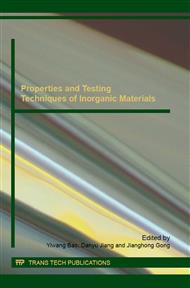p.498
p.502
p.507
p.511
p.515
p.520
p.525
p.529
p.534
Preparation and Photoluminescence Properties of RE-Doped GaN Film by Sol-Gel Method
Abstract:
This paper fabricates rare earth(RE) La, Ce and Pr doped GaN film by sol-gel method and uses X-ray diffraction analysis (XRD), scanning electron microscopy (SEM) and photoluminescence spectroscopy (PL) to characterize and analyze their dimensions, morphology and optical properties. The results show that doped GaN film is hexagonal wurtzite structure and has good crystallinity. With the increasing of the Ce doping amounts, the particle size of GaN increases gradually. While augmenting the doping amounts of La or Ce can cause particle size to be smaller. Several RE doped GaN have inhibitory effects on yellow luminescence and generate red emission peaks. The GaN:La don’t appear photoluminescence peak except for the characteristic peak of GaN. Ce doped GaN appear emission peaks with narrow FWHM between 500~600nm. 5% Pr doping enhances the intrinsic excitation and blue band edge luminescence of GaN. Through the analysis, it can be found that La, Ce and Pr doping influence the grain growth and photoluminescence spectrum of GaN film effectively.
Info:
Periodical:
Pages:
515-519
Citation:
Online since:
February 2016
Authors:
Keywords:
Price:
Сopyright:
© 2016 Trans Tech Publications Ltd. All Rights Reserved
Share:
Citation:


